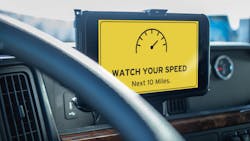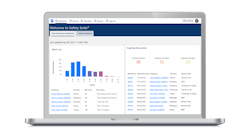In-cab safety technology improves 'human connections'
Fleet adoption of in-cab safety technologies has been touted to help vindicate commercial truck drivers involved in crashes and help fleets keep their operational costs in line. And today, the technology is also being used to deter predatory litigation tactics and nuclear verdicts.
From a regulatory standpoint, the Federal Motor Carrier Safety Administration (FMCSA) has introduced a Tech-Celerate Now initiative focused on the adoption of advanced driver assistance systems (ADAS) for commercial motor vehicles. ADAS categories include braking systems, steering systems, warning systems, and monitoring systems. Putting an emphasis on monitoring systems, these devices include driver- and road-facing cameras and camera-based mirror systems that fleets can use to monitor a driver’s behavior and performance. Drivers, however, have historically cited concerns over privacy when the subject of in-cab cameras and other behavior-monitoring technologies have been broached.
“Technology has and will continue to play an integral role in improving the human connections within our fleet,” explained Hayden Cardiff, founder and co-CEO at Idelic. “As we integrate and effectively use these systems, we will better attract and retain drivers and create a culture where drivers feel like they are being watched after and not watched over.”
“Our technology is based on geofencing and integration through the ELD partners,” Neil Fisher, Drivewyze vice president of sales and customer success, said. “When a fleet logs in, they have zones already set up, and what they see is how many drivers they had that sped through those zones. They can also see a snapshot of incidents within a specific period. It allows them to see which drivers were speeding and act on it so they can start to coach those drivers.”
Though the technology is based on tracking speeding, Fisher said it could also detect high collision areas, high rollover locations, and parking areas, which could be hotspots for accidents. According to Fisher, the biggest benefit for fleets is communicating with their drivers directly in the cab.
The technology also provides real-time parking notifications to help drivers find a safe place to park. Those real-time parking notifications are currently available in nine mid-west states, with expansion expected later on.
Overall, when it comes to implementing in-cab safety technology, the key for fleets is addressing challenges in real-time. “Every fleet, especially larger fleets, has hotspots where their drivers are having problems—maybe it’s citations, maybe it’s accidents,” Fisher explained. “But what they are keying in on is being able to immediately communicate with the drivers in real-time as these incidents and hotspots pop up.”
About the Author

Cristina Commendatore
Cristina Commendatore is a past FleetOwner editor-in-chief. She wrote for the publication from 2015 to 2023.


